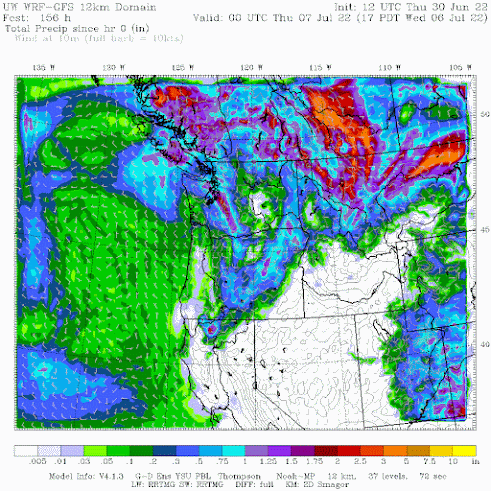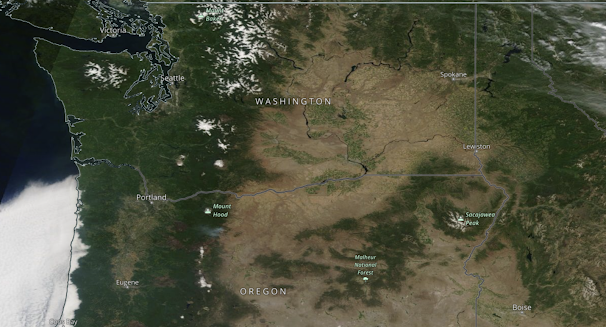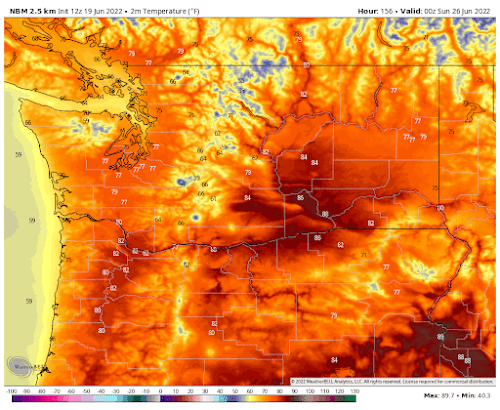On April 6, a wildfire was accidentally ignited by U.S. Forest Service personnel doing a prescribed burn near Hermit's Peak, New Mexico.
A prescribed burn is a deliberately set fire intended to reduce the potential for catastrophic wildfires by burning off surface fuels during conditions unlikely to cause an uncontrollable wildfire.
This Hermit's Peak fire began about 30 miles east of Santa Fe and 15 miles northwest of Las Vegas, NM. Joining another escaped fire two weeks later (the Calf Canyon Fire), the Hermit's Peak fire has now burned 342,000 acres and destroyed over 900 structures.
The area of the Hermit's Peak/Calf Canyon Fire as of June 27
The cost of fighting the fire is now over 250 million dollars and the total damage, all the responsibility of the Federal government, will easily range into the billions of dollars.
Satellite image of the fire area last week.
Red indicates burned area and bright orange shows active fires.
As I will describe below, none of this had to happen.
Inadequate use of meteorological forecasts and data, ignoring the large amounts of preexisting flammable surface fuel, and poor decision-making all contributed to this disaster. Climate change was not a major player in this wildfire, in contrast to the suggestions by certain media (e.g., Washington Post, Seattle Times) and some Forest Service officials.
Last week the Forest Service put out an official report on the incident. Although there was an admission of some deficiencies (like not having firefighting capability in place if the prescribed burn went wrong), the report provides an inadequate description of the conditions leading up to the fire and did not note the failure to take advantage of modern meteorological prediction tools. It also suggested, erroneously, a major contribution of climate change.
This blog will tell the real story.
Dangerous Accumulation of Flammable Fuels Before the Fire
Prior to the fire, the accumulated amount of surface fuels (e.g., grasses) was far above normal and very dangerous. This was documented on one of the Forest Service's own websites (fuelcast.net) and a specific warning of the danger BEFORE the fire was given by a leading Forest Service surface fuel expert, Dr. Matt Reeves.
Heavier than normal precipitation last summer during the Southwest Monsoon led to abundant grass growth, which dried out during the winter and spring under the influence of a moderate La Nina (which causes the southwest U.S. to be dry during the cool season). Neither of these conditions is associated with global warming.
Dr. Reeves (on March 1) noted that surface fuel density in eastern New Mexico was above normal (yellow and green colors in the figure below), representing a substantial wildfire threat. The location of the Hermit's Peak fire is indicated by the black arrow.
A Strong Wind/Drying Episode the Day Before the Fire
On the day before the fire, there was an intense drying event, with very strong, low-humidity, desiccating winds over the region. This is illustrated by the Hot-Dry-Windy index that combines wind speed and atmospheric drying potential (values shown below are for the area around the fire).
A HUGE spike of drying conditions occurred on April 5th. Think of it as a drying storm that quickly sucks the moisture out of dead grasses and other vegetation.
This intense drying was evident at a nearby U.S. RAWS weather station (Pecos, NM), where the winds gusted to 40-50 mph and the relative humidity dropped to under 20% on April 5th. Any grasses or light fuel were completely and utterly dry after the "drying storm."
An Ominous Weather Forecast Ignored on April 6th
Now we get to the day of the prescribed burn and runaway wildfire.
According to the official Forest Service report, there was no dedicated meteorological support for the burns and the only guidance was a few spot forecasts requested from National Weather Service forecasters in Albuquerque. The Forest Service report states that the key reason why the fire got away from Forest Service personnel was "variable and shifting winds." The truth is that such winds were clearly forecast well before the prescribed burns were initiated during the late morning of April 6.
Consider the operational National Weather Service HRRR forecast model, which is run at high resolution over the entire U.S. every hour, providing timely and accurate high-resolution weather prediction. These predictions were available to the Forest Service folks well before the burn.
Below are the HRRR forecasts of surface wind gusts. This forecast model run was started at midnight Mountain Daylight Time (MDT) and would have been available on the web by 2 AM April 6th (well before the fires were initiated by the Forest Service). The plots below show forecast wind direction and wind speed (plotted by UW research meteorologist Jeff Baars).
At 6 AM MDT, the predicted wind gusts were from the south near and east of Hermit's Peak, reaching 15-20 knots Winds were variable near the peak with strong northwesterly winds to the west.
By 11 AM winds had greatly strengthened to the east of Hermit's Peak and a surge of strong northwesterly winds began to push over the terrain just to the west of Hermit's Peak. A major wind shift and wind strengthening were about to occur. This is when they decided to light many of the fires..png)
By 3 PM, when the prescribed fires were starting to go out of control, northwesterly winds were predicted to hit the Hermit's Peak areas, with gusts to 20-25 mph. As shown by the observations at Pecos RAWS (shown above) and other local observing sites, this was a good forecast.To further illustrate the realism of the forecasts, below are the maximum gusts on April 6th. 26 mph at Pecos and 31 mph at Las Vegas, NM.
Maximum wind (mph) on April 6 in the fire area.
The substantial change in winds was also forecast by the National Weather Service National Blend of Models (NBM). Below are the forecasts for the Las Vegas, NM airport, made at 1 AM the DAY BEFORE (the times are all in UTC/GMT).
The gusts (GST) were predicted to be as high as 24 knots that afternoon. And the wind direction (WDR) was predicted to shift from southerly (17, 18) in the morning to northerly and then northwesterly (3, 5 to 34, 33) later in the afternoon.
The bottom line is that increasing winds and wind shifts were clearly predicted by the National Weather Service HRRR model and the NWS NBM system well before they occurred, and subsequent forecasts enhanced the threat further.
Thus, the strong, gusty winds with changing directions should NOT have come as a surprise to Forest Service personnel.
But it is worse than that: the air predicted to come across the terrain west of Hermit's Peak was far drier and thus more prone to burn.
The observed relative humidity plot at the nearby Pecos RAWS site (repeated below, Local Standard Time shown), shows this profound drying, with relative humidity dropping to BELOW 8% during the afternoon of the 6th.
Weather model forecasts the day before clearly showed the very, very dry air coming across the terrain from the west. Below is a high-resolution forecast (starting 6 PM the DAY BEFORE) of relative humidity.
The forecast for 6 AM shows moderate relative humidity (50-60%) around Hermit's Peak.
By noon, MUCH drier air was forecast (correctly) to move in, with values less than 25% at Hermit's peak and much drier air just upstream.
And by 6 PM, values were down to 10% and below.
So the morning of April 6th, Forest Service personnel made the decision to go ahead with a prescribed burn:
1. With surface fuel loading was much higher than normal.
2. The day after a severe drying event was taking place.
3. When National Weather Service operational forecasting guidance predicted a major wind shift and strong winds during fire operations.
4. When National Weather Service operational forecasting guidance predicted plummeting relative humidity during the burn period.
Furthermore, Forest Service personnel did so without dedicated meteorological guidance and did not ensure that there were sufficient firefighting resources to deal with an out-of-control fire.
These actions were not responsible and did not reflect the high standards expected of the USDA Forest Service.
These actions not only resulted in billions of dollars of loss, the disruptions to the lives of thousands of New Mexico residents, and the loss of valued natural and historical resources but also undermines the critical task of responsibly restoring the dangerously fire-prone western forests, damaged by decades of fire suppression and mismanagement.
Finally, there should be a special place in Hades for those in the media and in the government that blame such forest mismanagement and prescribed burn missteps on climate change, as illustrated by the article and headline below in the Seattle Times. Such misinformation/disinformation undermines our ability to fix western forests and puts people and the natural environment at risk.












.gif)
.png)
.png)
.png)


.gif)












.gif)























